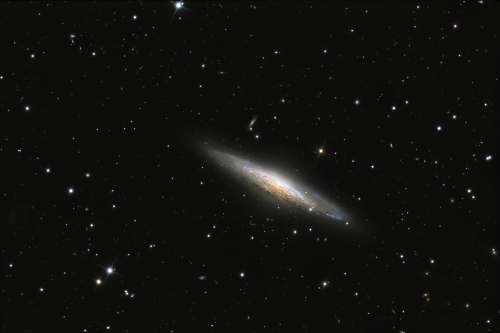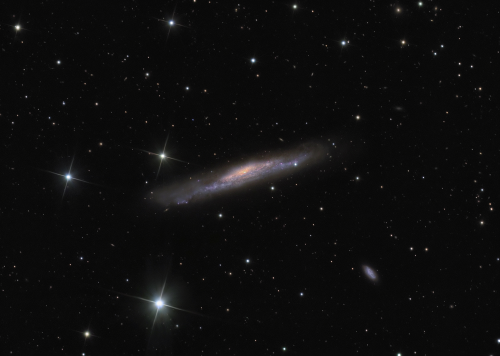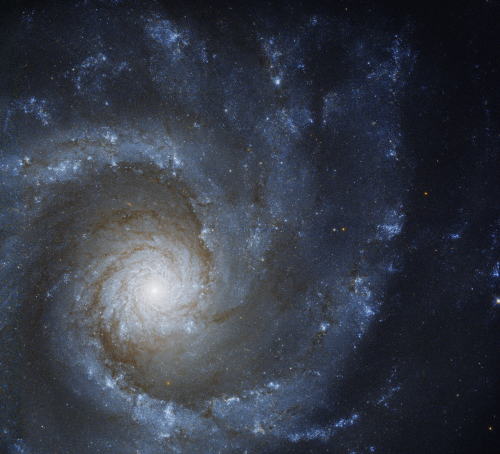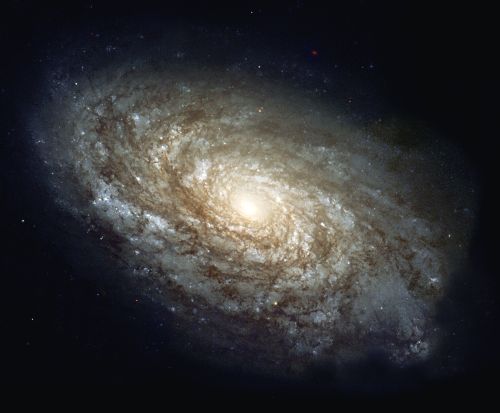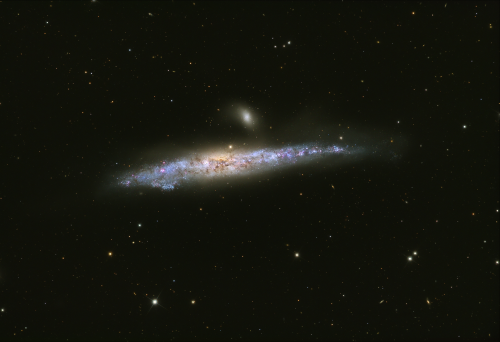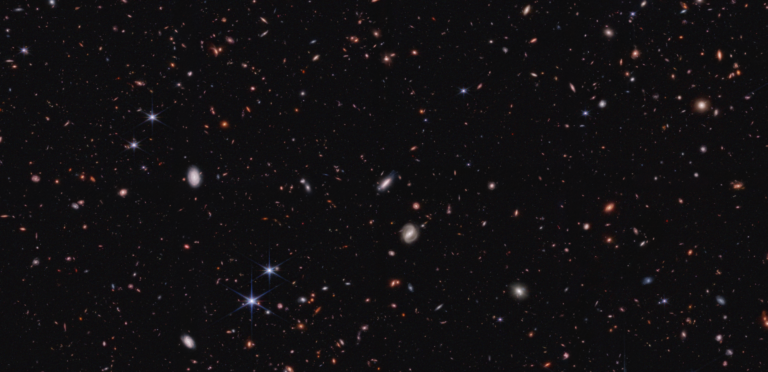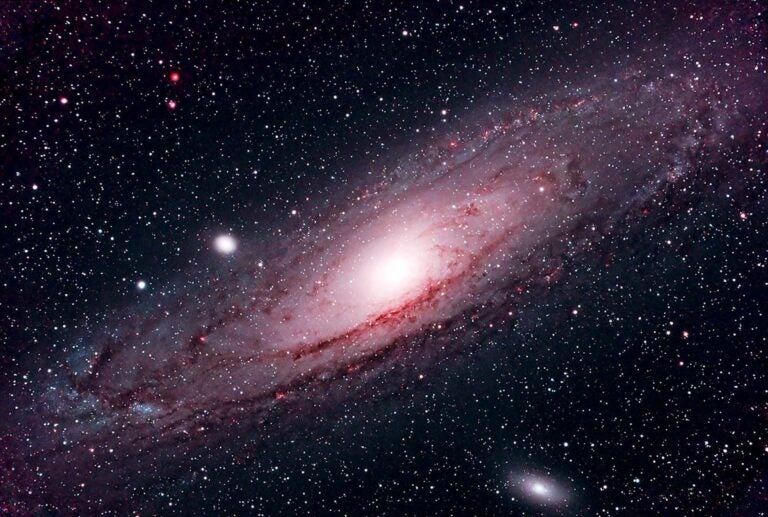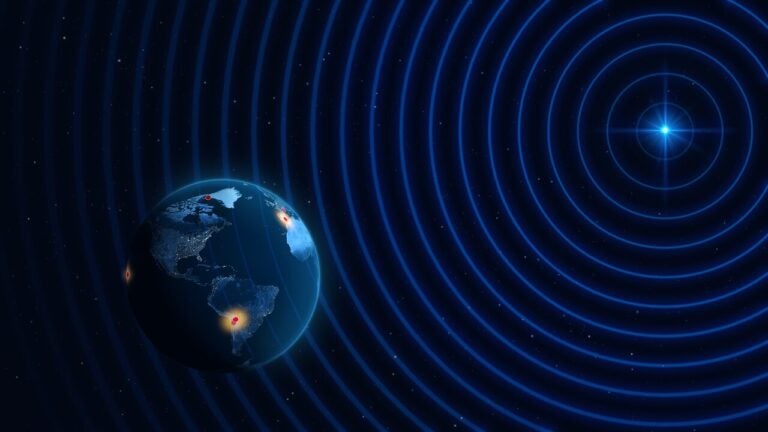The galaxies in this hunt run the gamut from striking to elusive. To approach this galactic scavenger hunt in a systematic way, I’ve divided the sky into four sections. In each section, we’ll follow a one-to-one extragalactic stitch pattern — first a needle, followed by a pin — looping our way from one region of sky to the next. (And in an effort to introduce you to some lesser-known beauties, none of the objects discussed below is on Messier’s famous list.) Let the needlework begin!
Section 1
The first section of sky we’ll examine lies in the constellations Lynx and Ursa Major.
We begin with our first needle, NGC 2683, located within the borders of Lynx, but about 1° northwest of magnitude 5.4 Sigma2 (σ2) Cancri. This luscious magnitude 9.7 spiral, which tilts just 11° from edge-on, carries the moniker “UFO Galaxy.” Through all instruments, it appears as a silver needle (9′ by 3′) elongated northeast to southwest. It also has a distinct sheen — like moonlight glinting off the blade of a sword.
Now thread your way to Tania Australis (Mu [μ] Ursae Majoris) and look only 45′ west for the Little Pinwheel Galaxy (NGC 3184). Seen nearly face-on, this magnitude 9.5 circular glow sports a 7′-wide disk hugging a stellar core. At a magnification of 100x, its disk breaks down into delicate waves of impure light. Note that the northern flank is punctured by an 11th-magnitude field star.
Next, turn your attention 2° northeast of Phi (ϕ) UMa to the spectacular edge-on gem NGC 3079. This galaxy tilts only 2° from edge-on. It is one of the nearest and brightest Seyfert galaxies, which have both glowing, active cores and clearly visible disks. Visible in a 4-inch scope at 100x, this 8′-by-1.5′ streak of light looks like a phantom Frisbee (oriented roughly north to south) near a triangle of stars.
Heading northward, we encounter the peculiar grand-design spiral NGC 3310. We see this face-on, 10.8-magnitude starburst galaxy less than 3.5° southwest of 44 UMa. Through a 4-inch telescope at 150x, it resembles a swollen planetary nebula 3.5′ across. It is one of the bluest spirals known, and it’s also the brightest disturbed galaxy in the late Halton Arp’s Atlas of Peculiar Galaxies. To see its arms well, however, will require at least a 12-inch instrument.
Section 2
Our second section lies entirely within Ursa Major.
Here, we come to our first challenge: magnitude 11.5 NGC 3448. I call this object the Cigarillo Galaxy because it’s an edge-on amorphous galaxy like the Cigar Galaxy (M82), only smaller. This smooth, 5′-by-1.5′ sheet of light hugs 44 UMa only 20′ to the southeast. Among the galaxies with the highest known rate of star formation per unit mass, NGC 3448 is interacting with UGC 6016, a 14th-magnitude dwarf 3.8′ to the west.
Also in this section, nearly 5° west of Phecda (Gamma [γ] UMa), we find the 10th-magnitude grand-design spiral NGC 3631. While only 4.5′ in extent, this nearly face-on galaxy sports a visual enigma — namely, one “heavy arm,” as Arp described it. This peculiar feature originates just north of the galaxy’s nucleus and points east. Those viewing through 8-inch or larger apertures should use magnifications of 150x to reveal this hefty appendage.
Visible in a 4-inch scope, NGC 4026 is a high-surface-brightness magnitude 10.8 edge-on lenticular galaxy in Ursa Major. Look for a starlike core punctuating its 4.5′-by-1′ needle-thin disk (oriented north to south), which swells with averted vision. You’ll find it about 3° south-southeast of Phecda. Larger scopes will also reveal its faint elliptical halo.
Next, turn your gaze about 1° north-northeast of Chi (χ) UMa for the last target in this section: the magnitude 10.5 grand-design spiral NGC 3893. Through a 5-inch telescope, it’s an elegant sight. The 4′-by-2′ spindle has a soft oval core, as well as fainter arclike extensions. Magnifications of 100x and greater will reveal a tiny nucleus and two high-surface-brightness arms wrapping tightly around the galaxy’s core.
Section 3
Our third section lies in two small northern constellations, Canes Venatici and Coma Berenices.
The first target, NGC 4111, lies near the border between Canes Venatici and Ursa Major. This small but fascinating edge-on lenticular galaxy lies about 1° due east of 67 UMa. It cuts a fine line against the night sky. A dark dust lane runs perpendicular to the galaxy’s plane, causing a dramatic decrease in brightness between the edge of the bulge and the beginning of the disk. Use at least 100x to see its bright starlike core, eye-shaped bulge, and hyperfine needlelike disk, oriented west-northwest to east-southeast.
Next, thread your way about 1.5° northeast of 14 Canum Venaticorum for the amazing flocculent galaxy NGC 5033. Visible with averted vision in 10×50 binoculars, this 10th-magnitude marvel is the visual twin of NGC 5005, which lies 0.5° to the northwest. This 5′-long lens-shaped object becomes increasingly more compressed toward its highly condensed core, a result of the galaxy swallowing a companion sometime in the distant past.
Our third target in the third section is the Silver Needle Galaxy (NGC 4244), which glows at magnitude 10.5 about 4½° southwest of Chara (Beta [β] CVn). This galaxy’s exactly edge-on disk (15.5′ by 1.5′) is devoid of a strong central bulge, but it does display a small central concentration. The galaxy orients northeast to southwest and, through a 4-inch scope at 75x, is a compelling ghostly ellipse with an uncanny sharpness to the galaxy’s slender shape.
Last but not least in this section, NGC 4414 is another superb flocculent spiral about 3° north of Gamma Comae Berenices. The 10th-magnitude galaxy’s 4.5′-by-3′ disk has a relatively high surface brightness and makes a good target for small-telescope users, even under suburban skies. A 5-inch instrument at a magnification of 100x will reveal the inner lens. This feature appears mottled along the major axis, and the outer lens has hints of knotty enhancements along what appears to be a spiral pattern, although nothing is connected.
Section 4
Our final section encompasses parts of Canes Venatici, Coma Berenices, and Virgo.
For a whale of a view, slide about 3.5° east-northeast of NGC 4414 to NGC 4631. Popularly known as the Whale Galaxy, this 9th-magnitude tapered monolith (oriented roughly east to west) is replete with dark vapors in a delicate embrace. Star clumps pepper the 15′-long disk like snowballs on the side of a house. For a triple treat, check out NGC 4627, a magnitude 12.5 dwarf elliptical galaxy 3′ to the north, and its equally slender partner, the Hockey Stick (NGC 4656/7), a magnitude 10.5 edge-on barred spiral 30′ to the southeast.
Next is a different sort of pinwheel. NGC 4725 is a peculiar one-armed spiral — a transition system between a normal spiral and a barred spiral that forms one of the most complete rings of any galaxy known. To find this magnitude 9.5 gem, look 2° south and slightly west of 31 Com, which lies near the North Galactic Pole. Through a 4-inch scope, the galaxy’s inner region displays a bar that connects a bright, broken inner ring surrounded by a fainter lens of light.
To find our next treat, travel westward to a point 2° due east of 17 Com. There, you’ll find the Needle Galaxy (NGC 4565). This magnitude 9.5 wafer of light has two 8′-long threads of light extending from the galaxy’s slightly swollen belly — like silk from a spider’s abdomen. A 4-inch telescope at high power will resolve NGC 4565’s classic dark lane, which cleanly divides the galaxy’s bright hub into two distinct ovals.
The last object is the Lost Galaxy (NGC 4535). While relatively bright (magnitude 10.5), this barred spiral is of low surface brightness, so it’s a challenge to small-scope observers. The 7′-long glow lies 2¼° northwest of 31 Vir and, in a 4-inch scope, shines as a circular patch of ill-defined light. Views through 12-inch and larger scopes bring out the spiral’s main, S-shaped arms within what I describe as “extragalactic ectoplasm.”
Bonus: A finishing stitch
We’ll end our needlework with magnitude 10 NGC 4762, an edge-on system 2° west and slightly north of Vindemiatrix (Epsilon [ε] Virginis). A 5-inch scope shows it as a 9′-by-2′ wisp sporting a nuclear bead within an inner lens. Bright dots flank the core, beyond which threads give way to hyperfine extensions. In larger scopes, the thin disk tapers to sharp points.
And with that, our galactic stitchwork is done. But there’s an entire universe at your disposal, and I encourage you to sew your own wonders together. As the late hand-knitting expert Elizabeth Zimmermann said, “Properly practiced, knitting soothes the troubled spirit, and it doesn’t hurt the untroubled spirit either.” Enjoy.

